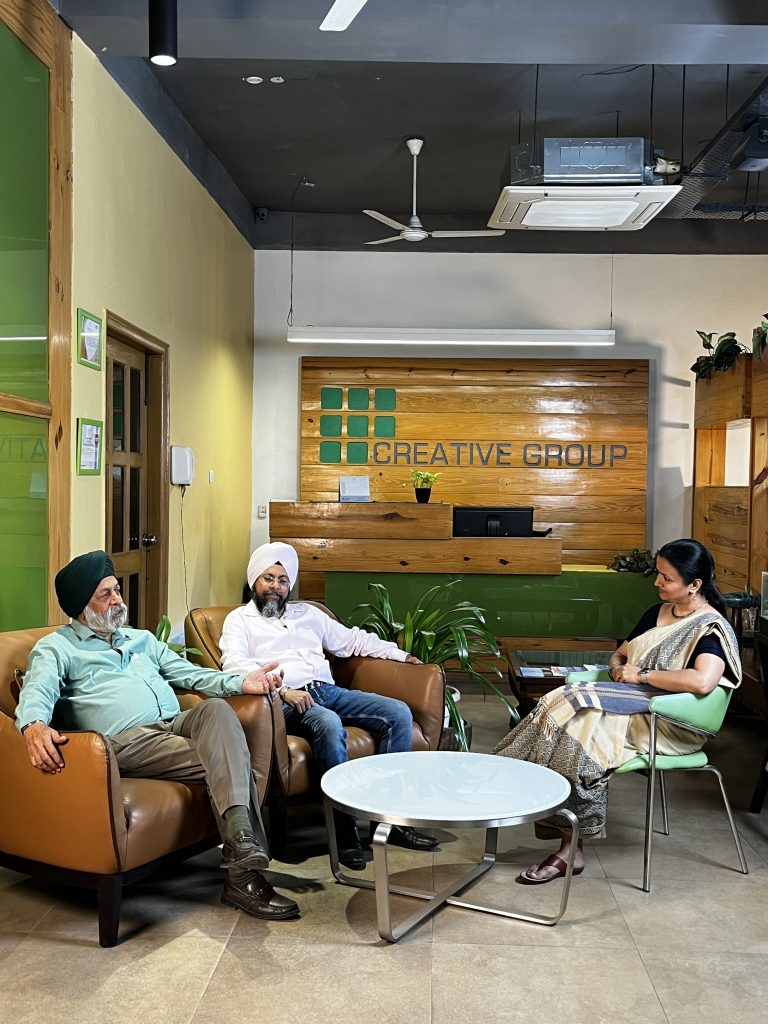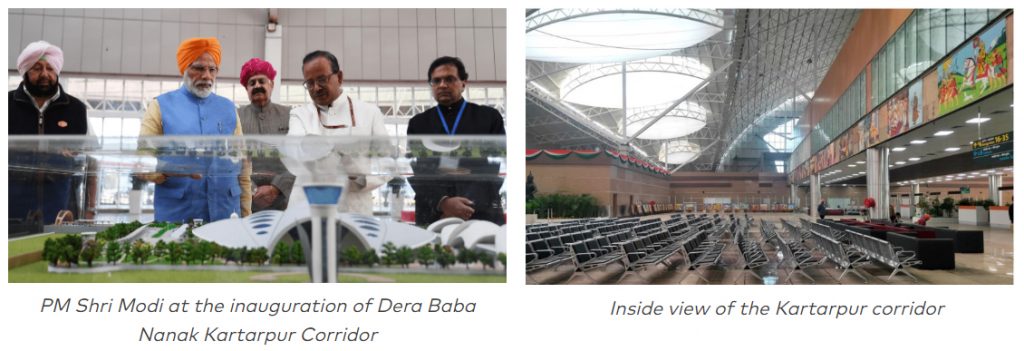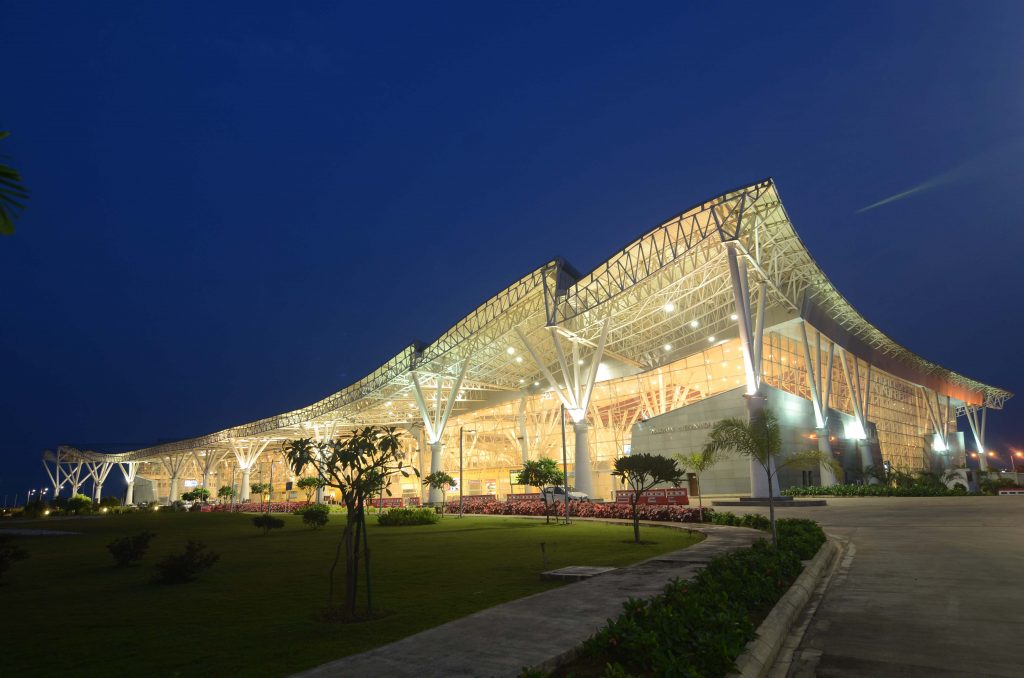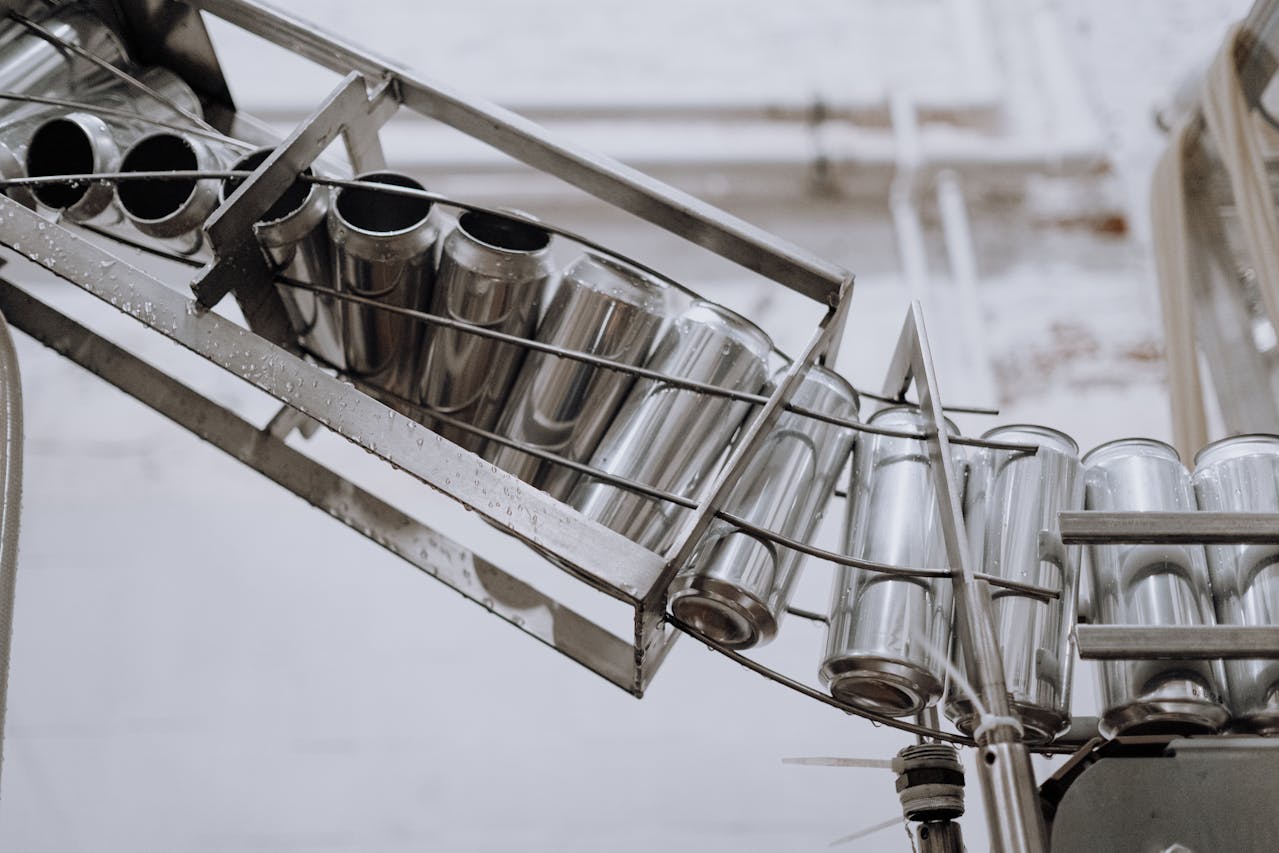Buildings that breathe – A tête-à-tête with Architects Prof Charanjit Singh Shah and Mr Gurpreet Singh Shah
March 24, 2023
When we enter the Creative Group, an internationally renowned architecture and design firm based out of Chhatarpur, New Delhi, we are surprised to be welcomed to an office grooving to Holi beats. Alongside me is a Professor of Sociology at the University Of Illinois, Chicago, who’s researching on accessibility of social infrastructure in Punjab, and hence awaiting an interview with Founder, Creative Group, Prof Charanjit Singh Shah. When Prof Shah does arrive, he is quickly whisked away by his team to join the Holi celebrations, where he takes us along.
And hence, even before our interview starts, we get proof that his work is akin to his office – immersed in local culture and groomed with love. In the words of Prof Shah, his buildings are “not dead mass of brick and concrete but a living organism which breathes and is embodied with the natural environment.”
Tell us something about your roots and your background

Prof Charanjit Singh Shah: In the olden days of 1947, my parents migrated from so- called Pakistan to India. I am a refugee born child. I was born in Purana Quila in a refuge camp and my parents groomed me without any financial assistance. They were passionate about me getting educated. I got admission in School of Planning and Architecture (SPA) where I studied Architecture. And this is how I slowly started. The passion I had supported me in giving me a lot of initiation. Which is why I say that if you have the passion, even sky is not the limit. You can go to any extent if you become a true Karmayogi.
I started and I was just like a freelancer, and after doing work for about 1.5 years and some of the great masters, who groomed and inspired me, like Joseph Orenstein, Le Corbusier, Achyut Kanvinde, Raj Rewal, Kuldip Singh…and all these great masters who really had a touch of soul in their architecture, and it was very truthful, sustainable architecture. So I wanted to understand them and practically copy them. Like a chef, who learns from a senior chef, and tries to understand how to put together various things, so that is how I started. With God’s grace, in 1971 I started the Creative Group from a small house. God has been very kind that today our bouquet is so full that we are now like a big corporate practice globally.
Watch the full interview here:
In your book Seed to Surrender, you call yourself an ‘incidental architect’. You just said that for a Karmayogi, sky is the limit – so what made you turn to architecture of all available options?
Prof Charanjit Singh Shah: At that time (when I started), engineering was strong enough, and architecture was a little component of that practice. We had just about 4-6 colleges of architecture that time, and the awareness was not that much. My father put me in touch with a few architects like Kuki Mathur (Architect PN Mathur), Jasbir Sachdev. When he introduced me to them, I could understand how an architect works. Then that made me attached to architecture. And I was very fortunate that I could get admission into a premier institution like SPA, so I was groomed by the best.
Why I call myself an incident architect is because I got admission in Jodhpur in Civil Engineering. And I opted for Architecture so that I don’t have to pay for hostel in going away from Delhi, so it was a financial decision to go for architecture! At that time I didn’t even know how to spell out architecture. I used to say, ‘archie-tect’ because that was my understanding, vocabulary and my level of information at that time.
Then slowly I could see that architecture is looking into many more things put together, and it’s a very passionate profession. Learning from the great masters, I could dig out how to connect the built form with the nature, and with philosophy. Sometimes, people think architecture is just a two-dimensional thing. But no, it’s a volumetical analysis of many more things put together. And I tried to do all these things myself. And that is how I am so proud and so satisfied that wherever we have worked, we have tried to put soul into architecture.
You and your group have been involved in the creation of airports, metros, railway stations, malls etc, and yet you have earned the moniker of ‘Airport King of India’. How did this happen?
Gurpreet Singh Shah: I think airports really changed the scale for us. When I came back after my urban design, we did a couple of international design competitions, and we were lucky that one of the mega projects of Chennai airport, which is almost 2 million meter square of built up area, that project we won. From there on, we have been doing n number of airports one after the other. And today we have completed more than 30 airports in the country and globally now we are working in Nepal, Africa, and also in some of the Airports in Europe. So the whole transformation of scale, from the small projects that Prof Shah mentioned about, to these very complex structures which are beyond architecture, and where various disciplines of architecture, engineering, and other disciplines also come together – this is where we really specialise. Where we are able to create a sustainable ecosystem for a project, and we are able to give a very sustainable and cohesive building as an end product to the user.

Prof Charanjit Singh Shah: Destiny plays a very vital role. You probably can work very hard, but somewhere your luck doesn’t favour. As Gurpreet has said, we were so lucky that entered four design competitions and we got all four! We got Chennai, Raipur, Vadodra, Goa. We were doing such large projects at the time when India was not shining like it is today. I think we were the first ones to bring technology. We were the first ones to bend half a meter pipe, 16mm thick, in India. We did the largest cantilever in any of the terminals in the world of 80 feet and 25 meters. We were the first ones to create steam cured box section girders in flyovers, the thinnest 400 mm thick and 80 mm waffles. So that technology intervention of global order empowered our engineering skills and our architectural ability to create that scale of volume. That’s why people started calling us as Airport Kings! Because now if you take Creative Group, we have done more than 35 railway stations, we are into waterways, airways, land-ports, ferry terminals, highways, metros…so in the infrastructure space today, Creative Group is a global player. We do A to Z in aviation, we do masterplans. The Nepal airport, which is 20000 hectares with four runways, and depression between two runways is more than 10 meters! So sizing out all these projects, making the master plan, understanding the return on money, making the feasibility and pre-feasibility study…all that we understand. And we are capable of delivering any size of project around the globe.
How has the role of stainless steel evolved in the field of infrastructure and architecture over the last few decades, especially in the area of sustainable construction?
Gurpreet Singh Shah: There has been a tremendous shift in how public buildings are made today. We used to make buildings where plaster used to be done, and in a couple of years, our buildings used to get into such a shabby condition that it used to be very difficult to say that it was a building designed by us! But today, buildings are designed in a very robust manner. And buildings are designed in such a way that most of the internal and external areas are totally abrasive resistant. So that whatever kind of public movement happens in the building, the building can take care of itself. So there has been a shift in terms of material usage, and stainless steel is a material which is very friendly in terms of public buildings. We have been using it for stainless steel claddings inside the airport terminals, even as stainless steel jaalis for facade cladding purpose, and there have been tremendous use of stainless steel in trolley fenders, railings etc. Stainless steel as a material is a very eco friendly material which can be utilized in various different purposes. In the last 15-20 years, steel and stainless steel, both of these materials have come to India in a really big way and we have moved from concrete to steel.

How did your association with Jindal Stainless begin, and how has the journey been so far?
Gurpreet Singh Shah: Our association with Jindal Stainless started in 2012 from Raipur project where they actually came forward to create this whole ecosystem of artwork and landscape. And the whole paraphernalia of stainless steel sculptures were created and we showcased the Bastar art, the local art in different facets through the utilisation of stainless steel. That project was designed by us and further implemented by the Jindal Stainless team

and it was also maintained by JSL team. So that’s how it began. And then we started to use their products and so on. Now, in most of our public buildings, our station buildings especially, we have been using Jindal Stainless’ cladding extensively. In Vadodra, we have used stainless steel cladding, in the backdrop of the baggage handling system, and we have been usingthem for trolley fenders, and for column claddings. In one of the malls in Raipur, which is one of the most sustainable malls, we have used stainless steel jaalis in the facade in the way of a venturi effect, to make the whole mall a comfort condition of 24 degrees without using the air conditioner – just through stainless steel jaalis. That is a great project that showcases how product design can be used in such a way that one can move away from active energy (based) air conditioning systems to sustainable passive design strategies where you can create the same comfort condition without opting for energy. And this was one of the key projects which was also awarded by the European Association as one of the most sustainable projects of that year globally.

counters and claddings at Chennai airport
Prof Charanjit Singh Shah: We’re now talking of building life span of 500 years, 300 years. India is shaping up in a new way. You talk about Statue of Unity, Statue of Oneness, Statute of Shivaji, or you can even talk about the Museum of Future in Dubai, or the Royal Museum in Abu Dhabi. They are true examples where extensive use of stainless steel is being adopted. Why not have the complete skeleton in stainless steel? Because it is now available.We didn’t have it 30 years ago when Lotus Temple was being made and (Fariborz) Sahba, the architect, used galvanized reinforcement. Today is the time when we transform ourselves from galvanized iron, from polluting paint coating to permanent stainless steel which can create corrosion free structures for years together, for centuries together.
What is your message to aspiring and budding architects across the country?
Prof Charanjit Singh Shah: It is not the aptitude which matters, it is the attitude which matters. The attitude brings aptitude. You need to learn more of things together, put into your bouquet, be informed, and then command. Do not demand that you become the captain till you are well informed, and today is the time to do the capacity building, the capability building. We need to be capable enough to deliver the right structure to the nation. I can proudly say that Gurpreet has taken the Creative Group to that horizon where we are trying to enhance capacity. Today we have 150 architects and engineers working and we (plan to) become a larger global player where we have a capacity of 500 people, 1000 people working, and we transfer knowledge to other parts of the world, not that we get knowledge from USA or from Europe.
Mr Gurpreet Singh Shah: We also take energy from the youth and it is always the young and the new architects who bring the new technology into favour. So if we are able to combine the youth and the experience, then we can really bring forward something excellent and something we’ve not thought about. And that can really shape the India of tomorrow, and we can probably reverse the brain drain, and we can provide the technology and our own architecture of India and culture to the world.






